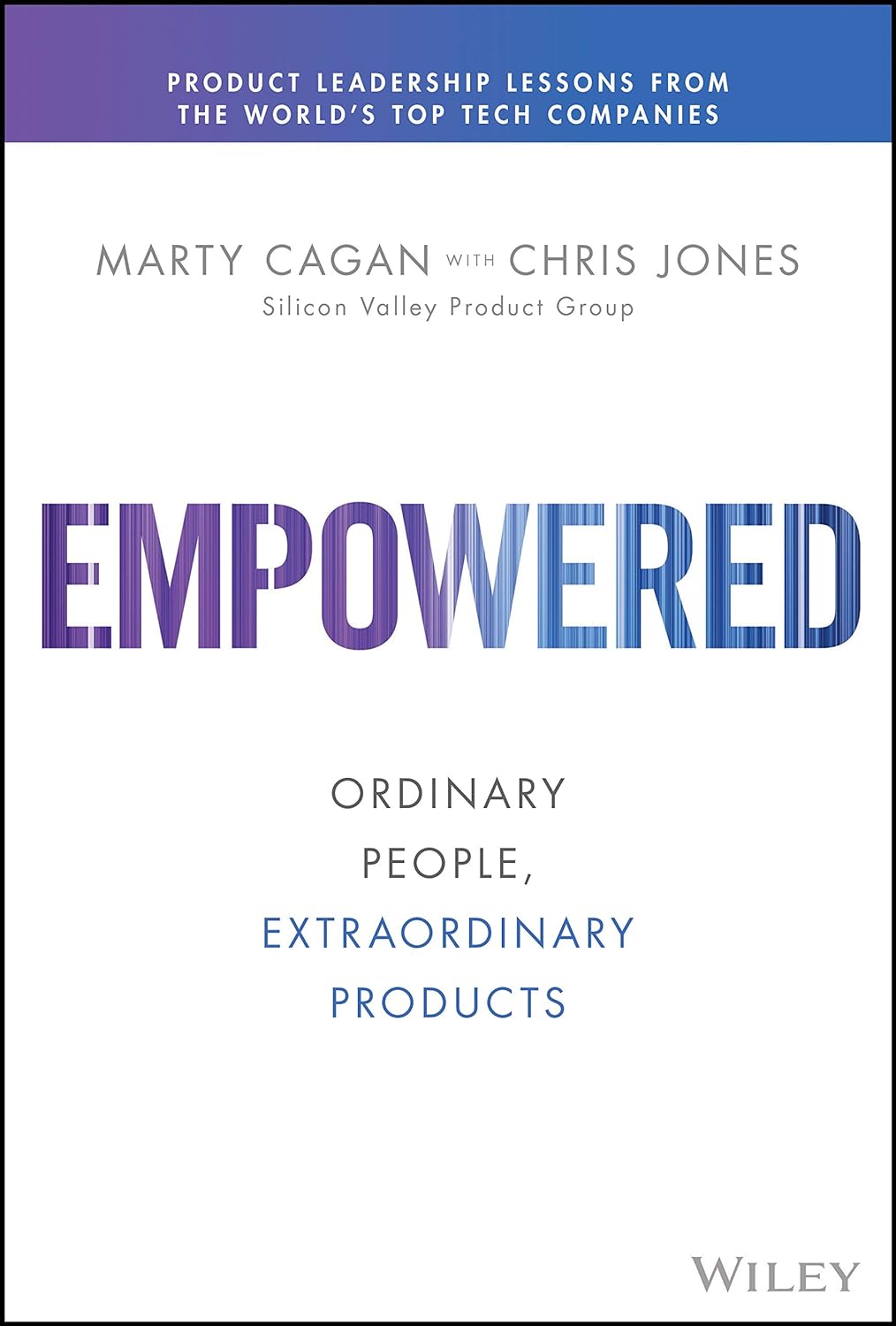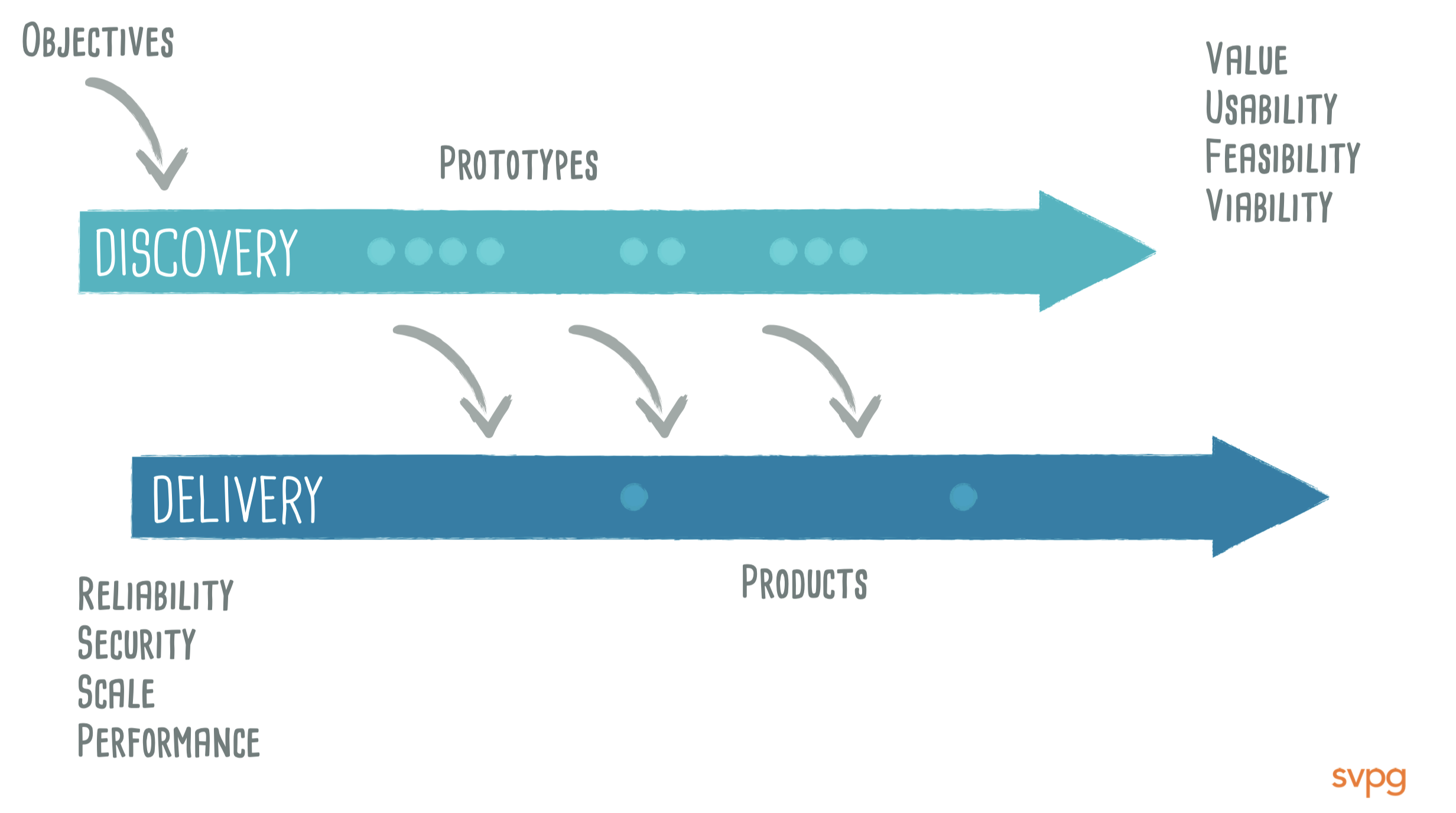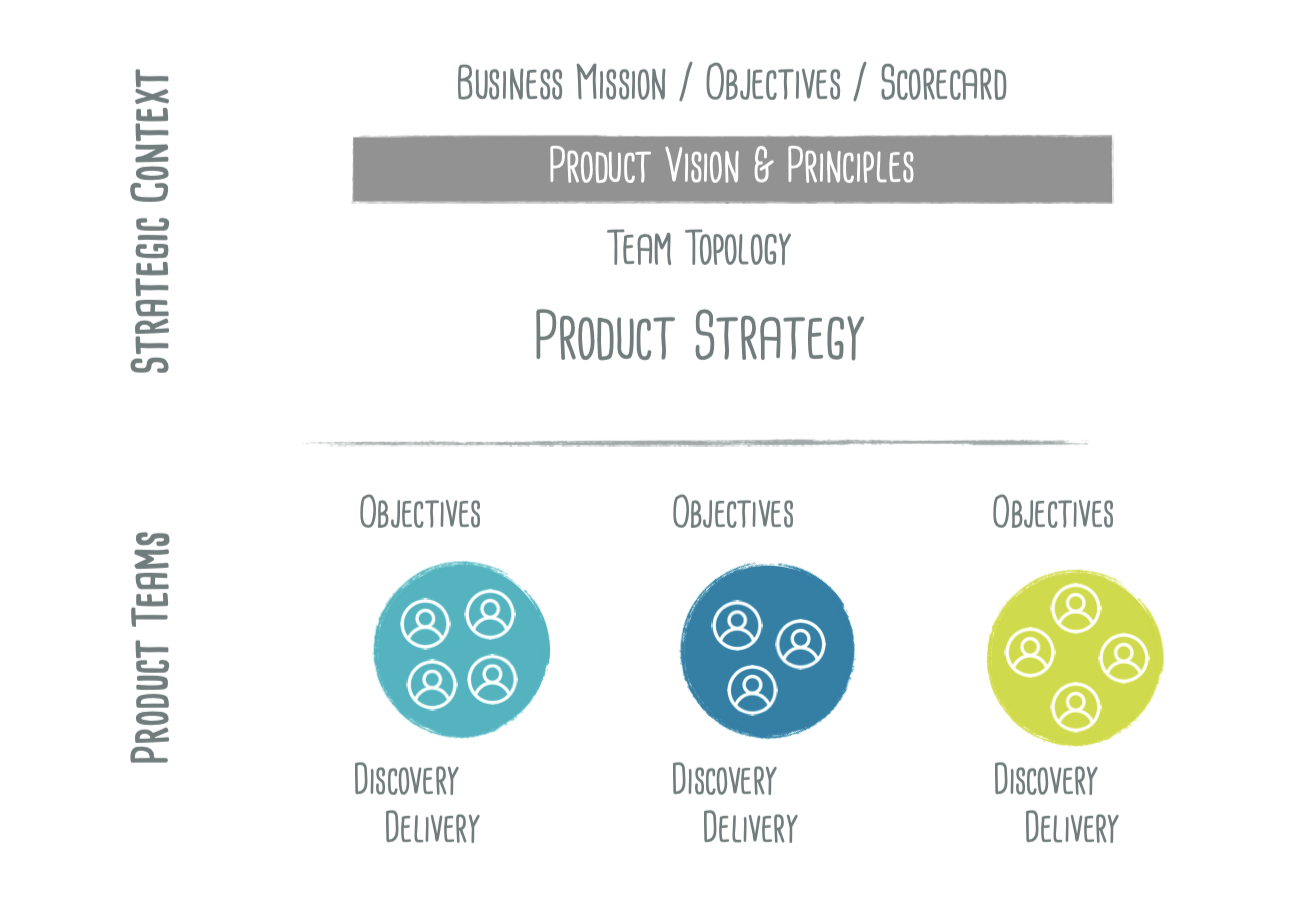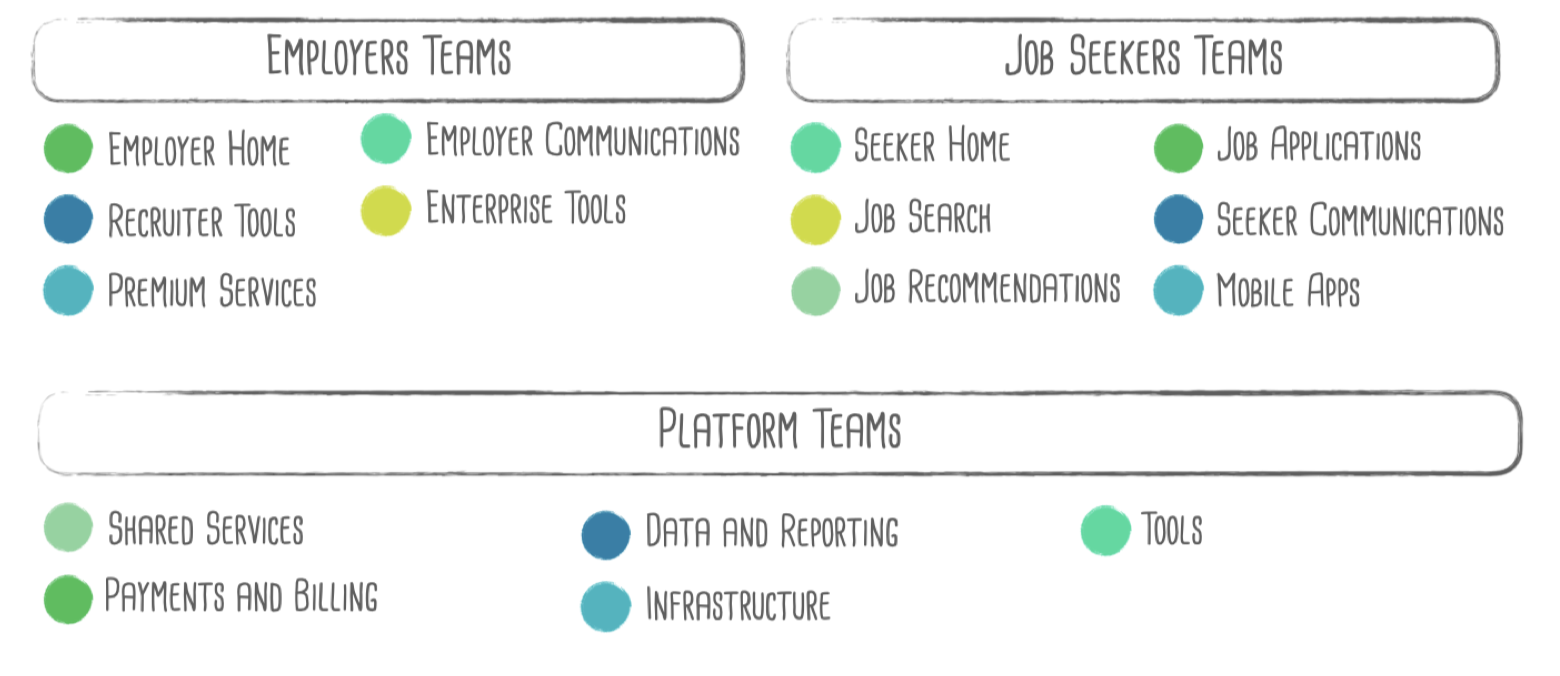EMPOWERED - Marty Cagan
All my notes from book and workshops with the master for product development Marty Cagan

Basic principles
Products are built by Product Teams
"Goal is to create this environment"
Power dynamics have changed
Feature teams is a subserviant model
Empowered teams are equal partners to the business
Empowered teams: giving the problem to the team to solve, e.g. too many customers churning every month
3 things that matter for Empowered Product Teams
-
Address product risk early
Value Risk - will they buy/use it?
Usability Risk - can they use it?
Feasibility Risk - can we build it?
Viability Risk - will it work for our business? Sellable, customers love it,...
→ Product Discovery
-
Define Products Collaboratively
Product Management
Product Design
Engineering
If you use your engineers only to code you only get half of it
"Work on problems instead of solutions"
-
Focus on Results, not Output
Shipping code is not enough; we must solve the problems we’ve been asked to solve
Focus on outcomes
Discovery team, delivery team
Product Discovery: as many prototypes as possible (multiple a day) created mostly by designers
and only put the ones that work on the backlog for delivery

Empowered Product Team checklist
- Small
- Durable
- Clear
- Ownership
- Cross-Functional
- Empowered to Determine Solutions
- Accountable for Outcome
Team size
1 Product Manager
1 Product Designer
3 Engineers
2 Other roles
"Lead with context, instead of control" - giving strategic context:
- Coaching and Staffing
- Product Vision
- Team Topology
- Product Strategy
- Team Objectives
- Evangelism
Good product companies do not outsource their engineers!!!
You cannot be a good Manager without being a good coach
Coaching - Assessment and Plan - give at least a year of material
Helping employee reach potential
NOT a performance evaluation
Combine with self-assessment, 360
Create Gap Analysis
Coaching plans - Create Plan to close gaps
Coaching Tools – The Assessment | Silicon Valley Product Group
If you don't provide the right coaching, somebody will do that
You join a company, bu you leave a manager
Coaching on:
- Ensuring Competence (Customers Data Business constraints Industry trends Technology insights)
- Thinking (The Written Narrative)
- Decisions (Right-Sized Analysis, Risk and Consequence, Collaboration, Disagreements)
- Effective Meetings (1st eliminate meetings, the rest effective)
Coaching - Thinking deeply in order to move quickly
The Written Narrative
“Writing the ::six-page narratives:: forces the author to conduct complete analysis, to distinguish between subtle nuances, to articulate the inner logic and set priorities for various ideas, and take full accountability for specific proposals. There is no wiggle room, no hiding place, and no safe haven. Everyone must put “skin in the game” and is to be held accountable for it.”
Amazon - decisions more made based on the charisma of that person instead of the content, no PPT only 6-pager, to be read in 20 min read, starting every meeting with that
Increased quality of deicsions significantly
Especially on Product Strategy decisions
Press release format, questions on it
Effective Meetings
Purpose of the meeting: Communication, Decisions, Problem solving
Keys to effective staffing
- The Critical Role of the Hiring Manager
The Critical Role of the Hiring Manager Invest in Active Recruiting Curating A Strong Interview Team Creating an Effective Onboarding Program
Manager has to own staffing
Analogy: Think of a Coach or Manager of a football club
You build a network of people you eventually want to hire
- Invest in Active Recruiting
- Curating A Strong Interview Team
- Creating an Effective Onboarding Program
"No assholes" - toxic people
Google: "It's just about getting competent people and creating trust with them together"
How to identify assholes in interview: check social media
"Agile coaches help engineers on delivery"
The Empowered Model
First Product-Market-Fit then Product Vision
Most pivotal thing for a company
Nothing else in product that pays of like Product Vision
EMPOWERED MODEL - pushing down decisions (authority and responsibility)
Get the most out of your talent in your company
Lead with context, not control - opposite of command & control
Every company has a purpose, usually referred to as mission
Fits on 3 pages, it’s most probably not a product vision
INSPIRE everybody!
Canvas not enough
Not outsource engineers - mercenary model!!!

Strategic Context
Business Mission / Objectives / Scorecard
Business objective, e.g. Netflix, produce and go global
Scorecard showing the health of the business (CFO + CPO), are we doing well or not (growth, churn, )
Marketplace health, look at both sides, is the balance right
Product Vision & Principles
- Customer Centric, how it makes your customers life better
6 engineer co-founders, sold ‚engineering automation‘ to Siemens Medical, founded Workiva, started on who w gonna help
- North Star
- Inspires Meaningful Work
- Leverages Industry Trends, e.g. Machine Learning, Web 3,
- Informs Architecture, Product Vision drives architecture ->
- Informs Team Topology, it’s all about „highly aligned but losely coupled teams“
- Reflects Values and Principles, not just what, but also how you do it
- Best Recruiting Tool, single best recruiting tool! they wanna work on something meaningful, that’s what attracts them.
3-5 years for software
10 years for hardware
As a Marketplace would you also include both sides, demand and supply as customers?
So instead of customers -> users?
Von Ben Matthews zu Alle (17:38)
@Daniel - Not sure if this is the "right" answer to your question, but when I worked in Seller Services in the Marketplace business at Amazon we had the two "customers" - 3rd party sellers on the platform and "buyers" (i.e. the end user purchasing on Amazon). We navigated the decisions of which customer to prioritize through product "tenets" which were akin to product principles. In tradeoff decisions, the "buyer" was nearly always the priority - which was certainly a pain point at times for the other "customer", the sellers. In the written narratives we used "sellers" and "buyers" language instead of saying "customer".
One example of how the tenets played out is how (almost) all seller pages look the same. Many sellers - especially big brands like Apple, Nike, etc - wanted their own branding on their pages - but we felt the UX for buyers would be impacted negatively if seller pages had different look/feel. So the tenet guided to keeping the UX best for buyer, not what individual sellers wanted.
Sales-driven product
Many have Direct Sales, often an effect Sales-driven product, Sales is driving the product, if there isn’t a product vision Sales will fill it
Otherwise they ask for a roadmap, much rather share product vision
Sales model is disrupted by product-led model
Everybody suffers from tech debt if it’s only few years old, growth has been so fast and huge,
Roadmaps
Jeff Bezos: „Be sutborn on your product vision, but flexible on the details“
It’s not about roadmaps at all, it’s about which problems are you solving
Problem: Put items on roadmap before doing product discovery!
Roadmap lockin into a bunch of deliverables which most probably will not solve these problems
If roadmaps, maximum for a quarter
Communicating Vision - Inspire!
Main purpose is to inspire your company
- ::Visiontype:: / User Prototype, it’s a simulation about the whole user experience
Examples | Silicon Valley Product Group
- Vision Video
- Storyboard
- PR / FAQ
You cannot overshare the product vision
The Secret Tesla Motors Master Plan (just between you and me)
Team Topology

3 tribes, a set of product teams / squads
Typical for marketplaces
How many teams should we have?
What is the charter & scope of each team? Where do you draw the boundary (Search / Recommendations)
What are the dependencies between teams? Bottom-line, minimize dependencies, but there have to be dep.
How do the teams relate to the technology?
How is success measured for each team? How large is each team?
What expertise is required for each team?
! Smaller number of large teams than a larger number of small teams
Scope of the team should not be too narrow
Netflix: „Highly Aligned; Loosely Coupled“
As much Ownership as possible, as Autonomy, Alignment
Empowerment - product team figures out how to solve the problem the best
Autonomy - we have everything we need to ship the product, usually limited by skills and capacity
Output is not really the same as outcome! → solving problems, not just shipping code
Trend in the industry is to invest in the platform, to have 50% of your engineers in platform teams
→ enables experience teams to have a larger responsibility for experience
Experience Teams - Customer facing or customer enabling
Platform teams - common services
Customer-enabling teams → Supply chain, …
::Platform teams::, very prestigious team, best engineers on that team, force multipliers
with ::Platform Product Manager::
Kraken, PIT
Enable other teams, Enablers
Case Study AirBNB
Guests, Hosts
There are always interactions!!!
Responsibility
Head of Design, e.g. Apple, coordination across teams!
Head of Product
Discussion
Around 60 engineers, 14 teams
Purchaser Experience, Supplier Customer Experience
Cross-functional teams, Product Design Lead, QA Lead
Purchaser experience group, Supplier Product Group
Haven’t clustered it like that, don’t call them platform teams and platform Prdocut Managers
Q&A
Platform teams as bottleneck, has to be fixed fast enough
It’s not hard to see
Change allocation of engineers
How to align experience teams with platform teams
::Delivery Manager = Project Manager, focussed on dependencies, bottlenecks and impediments::
= Project Manager
„It’s all about the ability to connect the dots“
Discovery Team for new Product Development
→ SVPG Platform Product Manager
::Platform Product Manager is usually a former engineer::
No separate Product Discovery team from the Product Team (Innovation Theater), never introduce 2 classes of Product Development
Put Bangalore Product Development Team together (is also the Google model)
::Remote harming significantly Discovery, not so much Delivery::
Product Strategy
- product vision describes the future you are trying to create;
- product strategy helps us decide which problems to solve;
- team objectives assigns those problems to specific product teams;
teams doing:
- product discovery helps us discover a solution; and
- product delivery builds that solution to bring it to market.
Product Strategy - Connects the business objectives and product vision to the work done by the product teams. It solves for as much of the business objectives as possible, by determining what product objectives to pursue, and by which teams.
Break work up into managble steps
Good strategy does not pop out of some “strategic management” tool, matrix, chart, triangle, or fill-in-the-blanks scheme. Instead, a talented leader identifies the one or two critical issues in the situation—the pivot points that can multiply the effectiveness of effortand then focuses and concentrates action and resources on them.
Good Strategy Bad Strategy
Elements of Product Strategy
Focus
Selecting a small number of key levers for the business
saying no to the hundreds of other good ideas, Steve Jobs
Too many things is often fear of missing out, long list of different things
Kanban logic, it’s a fact that throughput is slower if you do too many things
Focus needs to happen, what are the most important things for the CEO to do
Let the CEO do this choice
Insights
That’s there you spent most of your time on
Mike McCue
- Insights from data, what people are actually doing, don’t implmement anything without instrumentation, „flying blind“, always tracking
- Insights from users and customers, be in front of users multiple times every week
- Insights from enabling technology, Mobile, Cloud Computing, Machine Learning
- Insights from industry, Industry analysts, Ben Thompson , Ben Evans
e.g. Facebook used insights on having at least 7 friends and implemented in the strategy
Put insights into
Tracking insights in our org:
Action
When you have a problem place the team
Superhuman Case Study
::You wanna train all of your people working on a product, when they encounter an insight you want them to immediately let me know as a leader! → role of leaders connecting the dots and it may impact the product strategy::
::Head of product, sharing insights in all-hands!!!::
Tracking and Data Analytics as part of product
Web Analysts as well as Data Analysts
Team Objectives - OKRs
BROKEN: „You ask all teams to come up with their own OKRs“
It’s our job to come up with the objectives
Key results come from the teams
We execute on the product strategy by assigning problems to solve in the form of objectives and their desired outcomes (customer or custome problem)
::Team Objectives „per team“ defined by the leadership::
::OKRs literally invented for the Empowered Team Model::
CEO invents a few objectives for the company
Head of Engineering is asked to come up with a set of OKRs for Engineering, … → whole
::Cascading OKRs are not fine in Product organizations!!!!!!! Please don’t do that::
Think through → Priorities defined by team!
ASSIGN PROBLEMS TO SOLVE
Team Objectives - Ambition
How ambitious does leadership want this team to be in pursuing this problem?
Looking for 10% or 10x? Roofshot or Moonshot?
80% confidence or 20% confidence?
Team Objectives - Commitments
High-Integrity Commitments - team is given a problem, do enough product discovery to be able to know what you will do will solve the problem and you know when you can deliver it
1 or 2 objectives per team per quarter, per objective 1-2 key results, one main result other „back stop KPIs“ check metric
Best OKR knowledge
Felipe Castro | Build an outcome-driven culture
Team Objectives - Collaboration
Shared Objectives, across e.g. 2 teams shared is usual - strong collaboration
Common objectives, for hard problems, e.g. churn rate is too high! Company is bleading money
Going to several teams work on that independently
::Product attribution ‚problem’:: - how much a certain change in the product contributed to the Key Results
Gold standard: A/B test, isolates the contribution of one team
Case Study and Transformation
Company Objectives - 2 goals for the year
O: Continue to grow the core business
- Revenue
- Employer Churn, lower churn
- Seeker Success, How many seekers find a job
O: Establish us as proven provider for enterprise-class employers
- Reference customers
- GTM
NPS was high, but only 30 jobs were filled
Insight: If you don’t use the app, people use Google, SEO, the next 30 min you end up with another marketplace, App incredibly important!!!
Vision: just help job seekers to find the best job and help employers find the best candidateOIB
2-3 platform teams were overwhelmed, they haven’t had platform product managers, instead the Tech Leads were POs, didn’t work for these services
Apps only important for job seekers
Identify bottlenecks and mitigate that
Quarterly Planning, done by the core group:
- VP Product, 3 Product Directors, CTO, Head of Design
- Choose focus areas, set team context
- Describe upcoming planning process
48h to success for a job seeker
Examples of Active Management
- Too much work on one team identified
- New dependencies identified
- New required skills identified
- Replatforming adjustment
- Distributed some shared services work
Key takeaways
- Leaders were very involved
- Good objectives empower teams
- Good strategy is key to good objectives
- Teams may volunteer objectives, leadership is ultimately responsible
- Teams establish key results
- Normal for teams to collaborate on tough objectives
- Normal for different teams to pursue different approaches to tough objectives
Qualitative insights are usualy the most impactful!
Product Ops
Product Ops Overview | Silicon Valley Product Group
Product Ops: User Research and Data Team
Key success
Senior Leadership Support
Role of Technology / Software (impact goes beyond Product and Tech)
Understand impact beyond Product (Finance, Marketing, Sales, HR, Legal, BizDev)
Strong Product Leaders (Coaching and Staffing, Product Vision, Team Topology, Product Strategy, Team Objectives, Ongoing Evangelism)
Strong Product Managaers (Deep Understanding Of: Users and Customers, Product Data, Business Constraints, Industry Trends/Landscape)
Empowered Engineers (“Nothing is more important than an empowered engineer.“, Bill Campbell)
Insight-Driven Product Strategy (Focus, Insights, Action, Management)
Business Collaboration (Transitioning from a subservient model to a collaborative model.)
Constant Evangelism (“We need teams of missionaries, not teams of mercenaries” - John Doerr)
Corporate Courage (Being willing to take the leap takes courage, especially for leaders that have never before worked in a strong, technology-powered product company.)
My SUMMARY
People
- Set a High Bar for Managers
- Coaching Plans for Every Product Person
- Hand Picked Interview Team
- New Employee Onboarding
Your Strategic Context
- Establish Dashboard Metrics
- Share Product Vision and Principles
- Review Team Topology
- Establish Product Strategy
- Use Strategy to Drive Team Objectives
Team by Team
- Ensure the necessary skills
- Assign Team Objectives
- Re-Introduce the Team to Stakeholders
- Hold the Team Accountable to Results
“If you want to make everyone happy, don’t be a leader sell ice cream.”
- Steve Jobs